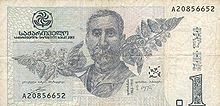Georgian lari
| lari | |
|---|---|
| Country: |
|
| Subdivision: | 100 tetri |
| ISO 4217 code : | GEL |
| Abbreviation: |
|
|
Exchange rate : (29 Mar 2020) |
1 EUR = 3.8291 GEL 1 CHF = 3.55831 GEL |

The Lari ( Georgian ლარი; ISO code : GEL) is the currency of Georgia . It was put into circulation by the National Bank of Georgia (NBG) on December 25, 1995 (according to other information: October 1995). 1 Lari equals 100 Tetri.
The word Lari means both treasure and property in Georgian . Tetri is an old Georgian term for white , which refers to silver coins in pre-Christian times. Later the word was generally carried over to silver, gold and copper coins , mentioned in sources since the 14th century .
Banknotes are in circulation in denominations of 1, 2, 5, 10, 20, 50, 100, 200 (was issued later) and 500 Lari. The first editions were printed in France. They show pictures of Niko Pirosmani (1 Lari), Sachari Paliaschwili (2 Lari), Iwane Jawachishwili (5 Lari), Akaki Tsereteli (10 Lari), Ilia Chavchavadze (20 Lari), Queen Tamar (50 Lari), Schota Rustaveli (100 Lari), Kakuza Tscholoqaschwili (200 Lari) and David, the builder (500 Lari).
There are coins in denominations of 1, 2, 5, 10, 20 and 50 Tetri and since 2006 also 1 and 2 Lari. With the first coinage in 1996, motifs from the ancient history of Georgia were used on the obverse of the pieces. The obverse of the 1 Tetri coin shows a grapevine relief from the west facade of the Svetitskhoveli Cathedral . The 2 tetri coin depicts a peacock, which is a mythological motif in Georgia that stands for resurrection and immortality. The 5 Tetri coin shows a lion statue, which in the original was an object made of gold from the 3rd millennium BC. . AD represents an archaeological find from the Alazani -Tal. On the obverse of the 10 Tetri coin is the image of the Holy Father riding a lion, after a gilded tondo made of silver in the Gelati monastery (early 11th century ). The obverse of the 20 tetri coin features a deer with large antlers, a motif in a painting by Niko Pirosmani. The 50 Tetri coin bears the image of a firebird ( griffin ) based on a motif in the Samtawissi Cathedral .
All Georgian banknotes except the 200 lari note had the Georgian Bordschghali , a sun symbol with seven wings, on the obverse until the issue of 2016 . In addition, the issuing bank and the value of the note can be read in English on every Georgian banknote, for example: "National Bank of Georgia - Two Hundred Lari" . In 1999 and 2000 the National Bank issued modified banknotes with new security features. In February 2016, a new edition began with the issue of the new 20 and 50 Lari banknotes.
The Lari is freely convertible. He solved the Georgian coupon currency (Georgian Kuponi ) from a Token that between 1993 and 1995 in parallel with the Russian ruble was used and Western currencies.
Coins
- 1993
- 2006
Web links
- Official website of the National Bank of Georgia (Georgian and English)
- Current course of the Georgian Lari (GEL) (Georgian and English)
- The banknotes of Georgia (German, English and French)
Individual evidence
- ↑ a b c d Nino Ketchagmadze: The new Georgian currency . In: Caucasian Post . No. 5 (May 1996), pp. 3-4, CUNA Georgica, Tbilissi
- ^ National Bank of Georgia : Coins . on www.nbg.gov.ge (Georgian, English)











